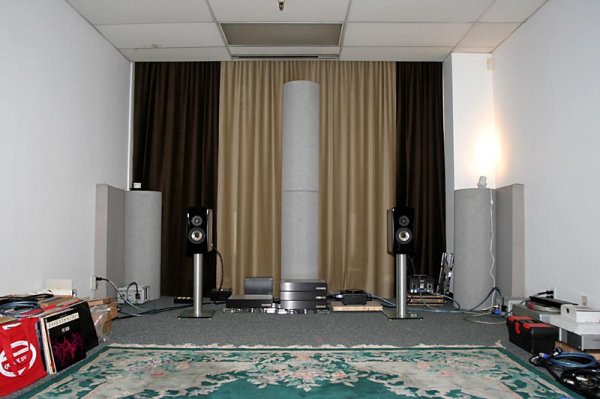garylkoh
WBF Technical Expert (Speakers & Audio Equipment)
Art, I think you mean Doug's MTF. Mine is just a mess below 40Hz - that might be the truck outside my window. The speakers have a lower frequency response of 52Hz.
For fun, go to Gary's MTF, that's Modulation Transfer Function. Start on the far right. We are going to count tone burst peaks. The first peak in fron the right is under the 2 of 20. That's 1. Now 1 thru 6 are clean peaks. 7, 8 and 9 are scrambled peaks, not spikes as before. And then we see 10, a double peak. And if we continue we count over to 15 and there is another double peak. We talked about this before, I think. Anyway, here is the perfect example of a sound cancel reflection effect. Remember, time here moves from left to right. The left hand peaks of 10 and 15 are the rise in the loudness of the direct sound. All of a sudden a reflection hits the mic and instead of the peak continuing to grow, it gets partially cancelled. The pressure of the reflection is in time with but out of phase with the direct signal, and quieter. Still, the out of phase collision of the two wave trains gives us a dip in the sound level. And as long as the tone is on, the cancel reflection effect stays there, canceling. Then the tone turns off and what do you hear? Not the speaker, you hear the tail end of the sound canceling reflection whipping by your head until it also runs out of sound. I just love that. Art

Gary, would you have an idea what the volume would have been at the mic position? Also, curious with Doug's room, how much an effect the large glass area behind the listening position would make ...Mic was placed 15" 2" from the front of the loudspeakers. and 32" from the concrete floor. Behind the curtains you see are floor to ceiling glass windows
So, are those "remnants" the source of the scrambled peaks like the ones evident in my MTF at around70 Hz? What is the effect of equalization - a high-Q notch filter, for example (I am using a bunch of those across the 30-100 Hz region)?
Gary, Acoustic ceiling tiles tend to produce weak bass. Dealer showroom always learn this lesson the hard way. You have added weight to your ceiling tiles with the plywood. fiberglass transfers the weight evenly to the ceiling tile and allows no rattle between the two hard sheets. this was a good thing to do. double up your fist and thump the walls of your room, using the heel of your fist to transfer the blow. Listen to the thunder. Frequently in the 60 to 70 Hz range, eextensive reverb can come from the vibrational resonance of the sheetrock and stud wall assembly. ArtHere's a picture of my room from the perspective of the listening position. Pardon the mess.
When I did the recording, the mic was placed where I would be listening from. I'll have to do a recording one evening when HVAC is off and the construction crew are not working.
The room is typical industrial space office construction. 13' 7" wide by 22" long. Ceiling 8' 11" acoustic tiles backed by 1' fibreglass backed by 1/2" plywood. HVAC unit sits on top
Mic was placed 15" 2" from the front of the loudspeakers. and 32" from the concrete floor. Behind the curtains you see are floor to ceiling glass windows.
View attachment 1771

Gary, would you have an idea what the volume would have been at the mic position?
Gary, Acoustic ceiling tiles tend to produce weak bass. Dealer showroom always learn this lesson the hard way. You have added weight to your ceiling tiles with the plywood. fiberglass transfers the weight evenly to the ceiling tile and allows no rattle between the two hard sheets. this was a good thing to do. double up your fist and thump the walls of your room, using the heel of your fist to transfer the blow. Listen to the thunder. Frequently in the 60 to 70 Hz range, eextensive reverb can come from the vibrational resonance of the sheetrock and stud wall assembly. Art
"EQ'd flat and still sounds flat", which means it isn't musical, even if it is EQ'd flat. There is more to musicality that a flat frequency response.
It was about listening level - 79dB.
Speaking of listening levels. Most hot rodders know how fast their car can go. And, most audiophiles know how loud they can play their room. It might be interesting to honestly compare listening level limits for different system/rooms among the participants. Who knows how loud they can play their room and still be listening to quality playback? Remember, this level is an overall average program sound level. It includes the distortion free playback of typically very loud and short lived dynamic transients in program material.
Why do rooms have level or loudness limits? Thought you'd never ask.
Why do rooms have level or loudness limits? Thought you'd never ask.
| Steve Williams Site Founder | Site Owner | Administrator | Ron Resnick Site Owner | Administrator | Julian (The Fixer) Website Build | Marketing Managersing |

